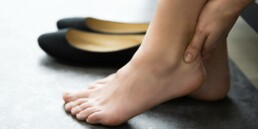Standing work is a reality for many individuals, especially in professions such as cashiers, teachers, cooks, hair stylists, or nurses. However, when prolonged, standing work can impact foot health, leg health, and blood circulation. In this article, EVO explores the pros and cons of standing position and best practices for preserving lower limb health.
Is Standing Work a Good Idea?
Advantages
- Reduced risk of sedentary-related diseases: Standing work promotes light physical activity throughout the day, helping to reduce the risk of cardiovascular diseases and diabetes.
- Increased caloric expenditure: Standing burns more calories than sitting, ideal for maintaining a healthy body weight.
- Improved posture: Working while standing encourages better body posture, thus reducing the risk of musculoskeletal disorders.
Disadvantages
- Increased stress on feet and legs: Prolonged standing work can lead to pain in the foot, leg, and lower back.
- Increased fatigue: Workers who stand may experience faster muscle fatigue and reduced daily concentration.
- Increased risk of circulatory issues: Prolonged standing can result in poor blood circulation in the legs, increasing the risk of venous insufficiency and heavy legs.
Impact on Feet
Prolonged standing work can take a toll on the feet, leading to common problems. Heel pain is common, and over time, the arches of the feet may flatten, causing pain and increased fatigue. Bunions, corns, and calluses are also frequent concerns.
Impact on Blood Circulation
When you stand for extended periods, gravity can make it more challenging for blood to return to the heart, resulting in venous insufficiency and varicose veins. Don’t worry; mitigating these risks includes wearing compression stockings or engaging in simple exercises to stimulate circulation.
Wellness and Standing Work: Ergonomic Strategies
If your profession requires long hours of standing, there are solutions to enhance your comfort. For instance, consider alternating between standing and sitting positions whenever possible. Anti-fatigue mats can also relieve pressure on your feet and legs. Adjust the height of your workstation by investing in a sit/stand desk. You can also incorporate short, active breaks to stretch and move your legs.
Exercises and Stretches: Friends for Your Feet and Legs
You can perform simple and practical exercises to alleviate fatigue associated with standing work. Start with calf stretches by gently pushing against a wall with your heels to stretch the muscles. Rise on your toes repeatedly to strengthen your calf muscles. You can also perform ankle rotations in both directions to promote circulation. Finally, toe flexion and extension exercises can improve the mobility of your feet.
Foot Orthotics: Your Daily Allies
For optimal support during your workdays, consider wearing quality foot orthotics. The EVO Laboratory specializes in crafting custom foot orthotics to meet your needs. Our process begins with a comprehensive biomechanical assessment considering your posture, foot condition, ankle condition, and gait. We then use premium materials to create tailored orthotics. Finally, we conduct a follow-up assessment to ensure your comfort and the effectiveness of your orthotics in your daily life. With attention to detail, we ensure that your feet receive the best possible support for your prolonged standing work.
Choosing the Right Footwear
When selecting shoes, look for excellent arch support, quality cushioning, an appropriate size for a perfect fit, and breathability to keep your feet cool and dry.
The Importance of Maintaining a Healthy Lifestyle
Outside of work, it’s essential to maintain a healthy lifestyle to preserve your overall health. Regular exercise, such as walking, enhances blood circulation in your legs and helps prevent issues related to prolonged standing. A balanced diet rich in nutrients also promotes better blood circulation. Additionally, proper hydration is crucial to avoid dehydration, which can worsen symptoms related to standing work.
Medical Consultation for Persistent Pain
If you experience persistent foot pain or circulatory issues, it’s essential to consult a healthcare professional, such as a podiatrist or physician. Do not ignore your symptoms; early intervention can prevent more significant health problems in the future.
Standing Work: 7 Key Takeaways
Standing work is a reality for many professionals, with its advantages and disadvantages. To preserve your health and comfort, here are the seven essential points to remember:
- Standing work has advantages such as reducing the risk of sedentary-related diseases, increasing caloric expenditure, and improving posture.
- However, it has disadvantages like stress on the feet and legs, muscle fatigue, and circulatory issues.
- Common issues related to standing work include heel pain, arch flattening, bunions, corns, and calluses.
- Poor blood circulation can lead to problems like venous insufficiency and varicose veins.
- Ergonomic strategies like alternating between positions, using anti-fatigue mats, and adjusting your workstation can enhance comfort.
- Foot and leg exercises and stretches are essential for relieving fatigue.
- Custom foot orthotics, suitable footwear, a healthy lifestyle, and medical consultation for persistent pain are crucial for preserving health during standing work.
Does your profession require you to stand for long hours, leading to foot and leg discomfort? Please schedule an appointment with one of our orthotists, and let’s work together to find a solution that suits you.
Share this article
Related posts
October 4 2023
Standing Work: Impact on Feet and Blood Circulation
July 20 2021

